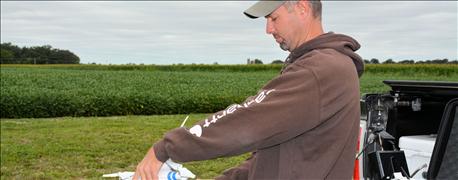
When a windstorm in July blew down half of the corn in one of Kurt McIntyre's fields, he unpacked his small rotary drone, sent it aloft and minutes later had aerial pictures of the damage.
Shortly after planting in the spring, he had the unmanned aerial vehicle airborne to inspect how well seeds in his corn and soybean fields germinated. Later in the season, he used it to determine if emerged plants were getting enough nutrients and water.
The drone is quicker, easier and much less expensive than the helicopter that McIntyre had hired in the past. This utility and low cost are why agriculture has become one of the biggest — if not the biggest — user of UAV technology.

Kurt McIntyre finds his drone indispensable for inspecting his Illinois farm fields.
McIntyre admits his $3,500 drone system, which includes a GoPro camera he bought separately, is at the low end of the price spectrum. Others cost up to $50,000 or more.
"Just because it is at the low end of the price spectrum does not put it at the low end of the performance spectrum," says McIntyre, who farms in central Illinois.
Related: FAA will require recreational UAV registration
While drones, also known as unmanned aerial vehicles, have been used in agriculture for a few years, the regulations governing them are still about a year away. Technically, what farmers are doing with drones is not yet approved by the Federal Aviation Administration, which regulates all flying things.
Hopefully, that will change in 2016, when the FAA said it will have regulations in place for private drone use. Until then, merchants who sell drones to farmers say the FAA has largely allowed their use in agriculture, providing they adhere to certain rules.
Stick to the rules >>
~~~PAGE_BREAK_HERE~~~
Stick to the rules
The rules include not selling drone-gathered information, not selling your drone services to others and obeying specific flight rules. Operators must also keep the craft under 400 feet, avoid airports and other aircraft, not encroach on public gatherings, and keep the drone in sight for the duration of its flight.
McIntrye says his drone quickly paid for itself. Previously, he would have had to either hire a helicopter and pilot, or physically walk his fields to locate damaged areas or areas that needed fertilizer, herbicides or water.
In addition to crop inspection, merchants of higher-cost systems say their programmable drones can fly and map fields for use in farm programs, fertilizer and water use, and insurance purposes.
The programmed flights do not require anyone at the controls, and when done, the drone will land at its takeoff point.
"We, literally, with our drones, can fly a 1,000-acre plot in a single flight and fly about 300 feet and get resolution down to less than an inch and see every single leaf on every single corn plant," says John Blair, co-owner of Event 38, an Ohio-based maker of fixed-wing and rotary UAVs. Visual reconnaissance of the land will tell if seeds germinate, fields have weeds, or deer are running around, he says.
"What used to cost thousands of dollars to collect via satellite and hundreds of dollars to collect via manned aircraft, we are now doing for pennies per acre," he says.
Related: UAV Technology Explodes onto Farm Scene
Filters can be added to drone cameras to determine plant health via the Normalized Difference Vegetation Index, a crop rating system used by USDA and universities.
"Normally, if you want an NDVI, you need to schedule a plane. The plane flies when it wants. You hope it's a sunny day when they fly and you wait up to 10 days for your map," Ed Kasper, owner of Illinois-based KasperAg Solutions LLC, wrote in a recent essay. "With a fixed-wing drone, you can fly the field that morning and have your NDVI map by lunch."
The benefits go beyond crops, although crop farmers are the biggest users. Thermal imaging cameras on drones can identify sick livestock among herds grazing on pastures.
What's next >>
~~~PAGE_BREAK_HERE~~~
What's next?
UAVs come in two forms, rotary and fixed-wing. The rotary type, often with four or six rotors and a battery life of about 15 minutes, is manually operated, easy to fly and fairly inexpensive.
The fixed-wing versions are typically more expensive, can cover more ground, fly 40 minutes or more, and can fly automated routes. But their advanced flight capabilities can put them in violation of current FAA rules because they can exceed the operator's line of sight.
One warning Kasper offered to Farm Futures readers is to do your homework and know what you want or need before buying. "The drone industry is so new it is the wild, wild West," he says. "There are people willing to take advantage of you."
Drones allowed in the U.S. weigh just a few pounds and can handle small payloads, like an optical camera or other sensors. Blair says in Japan, larger drones are big enough to carry and apply crop chemicals — and that may be the future in the U.S.
The biggest future advances appear to be in software — specifically, gathering and packaging it so farmers can quickly use it from their tractors or combines.
"Being able to integrate all of the sensors, from the drone to the farm equipment, is where we are going in the near future," Blair says. "The real challenge is to analyze and integrate all of the data we are collecting."
About the Author(s)
You May Also Like




